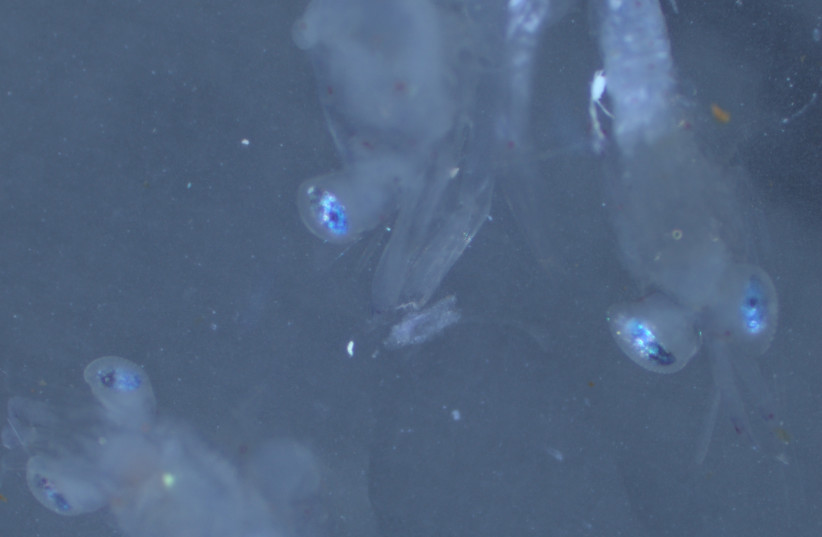Israeli scientists discover mechanism for scallops to camouflage eyes
Oysters, mussels and clams have a mechanism that makes the color of their eyes camouflage to match the color of the water they're in.
If you ever have the occasion to stare at a scallop – a mollusk with an interior muscle surrounded by two shells as in oysters, mussels and clams – you should know that it is staring back at you with more than 100 eyes. Not only that, but each eye is also a masterpiece of biological crystallization – thousands of thin square guanine crystals are tiled into a concave mirror that reflects light onto the overlying retina, enabling the scallop to see.
Dr. Benjamin Palmer and his doctoral student Avital Wagner in the chemistry department at Ben-Gurion University (BGU) of the Negev in Beersheba took a deep dive into scallops’ eyes using the latest in cryo-SEM microscopy to try and understand some of the mysteries about these crystals. CryoEM is a high-resolution method developed in the early four decades ago that uses an electron microscope with a “cold stage” and computers with powerful image-processing software to determine the 3D structures of small biological complexes.
In particular, they wanted to understand how scallops make plate-like guanine crystals, which express high reflective crystal faces, which are difficult to obtain in the lab.
Publishing their study in the prestigious journal Nature Communications, they discovered a new, intriguing facet of guanine crystals by studying juvenile scallops’ eyes undergoing development. The scallops can direct the growth to form ultra-thin crystals by using pre-assembled macromolecular sheets.
“This natural production far exceeds what chemists are capable of reproducing synthetically at the moment,” explained Palmer, “but they provide intriguing strategies for controlling the properties of synthetic crystalline materials which may be used for future pigments that do not rely on harmful chemicals, but on natural processes instead.”
 Dr. Ben Palmer. (credit: DANI MACHLIS/BGU)
Dr. Ben Palmer. (credit: DANI MACHLIS/BGU)How do scallops camouflage their eyes?
And now, Palmer’s second study about the camouflage capabilities of larval shrimp has now made the cover of the prestigious journal Science. Larval crustaceans are born in the sea and then float with the current, he wrote. Their only form of protection is that they are transparent. However, there is one part of their body that they cannot make transparent – their eyes. To see, they need dark eye pigments, which exposes them to predators. To circumvent this issue, they build a complex optical shield around each eye. The amazing thing about it?
"The shield reflects light that matches the shade of the water they inhabit. It ranges from deep blue to yellow depending on the water,” Palmer explained.
"The shield reflects light that matches the shade of the water they inhabit."
Ben Palmer
While discovering new aspects of the animal world fills Palmer with joy, there are practical future applications of his findings if they can be understood well enough. The findings – which reveal a particularly compact and tunable photonic glass in the “eye-glitter” structures of these animals – could be used to inspire the design of various materials.
“By mimicking nature’s solutions, humans can optimize and develop better photonic materials for solar energy, communications, remote sensing and other light-dependent technologies,” wrote Kate Feller and Megan Porter in a related Perspective.
Another interesting finding was that the process of making these crystals is strikingly similar to the formation of melanin, which is found in freckles. Their study is the first to link ultrastructure features of bio crystallization and melanin production by showing that the two processes develop quite similarly.
“It is now probable that one common stem cell governs these two processes in wildly divergent animals, Palmer declared.
“Larval crustaceans are born in the sea and then float with the current. Their only form of protection is that they are transparent. However, there is one part of their body that they cannot make transparent – their eyes. To see, they need dark eye pigments, which exposes them to predators. To circumvent this issue, they build a complex optical shield around each eye. The amazing thing is that the shield reflects light that matches the shade of the water they inhabit. It ranges from deep blue to yellow depending on the water,” he concluded.
Do scallops have eyes?
THIS PAGE WAS POSTED BY SPUTNIK ONE OF THE SPUTNIKS ORBIT BLOG


No comments:
Post a Comment
Stick to the subject, NO religion, or Party politics